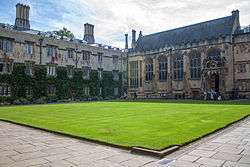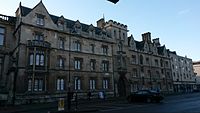Exeter College, Oxford
| Exeter College Latin: Collegium Exoniense
| |||||||||||
|
Floreat Exon | |||||||||||
|---|---|---|---|---|---|---|---|---|---|---|---|

| |||||||||||
| Rector: | Sir Richard Trainor | ||||||||||
| Website: | www.exeter.ox.ac.uk | ||||||||||
| |||||||||||
| Location | |||||||||||
| Grid reference: | SP51450639 | ||||||||||
| Location: | 51°45’14"N, 1°15’22"W | ||||||||||
Exeter College (in full: The Rector and Scholars of Exeter College in the University of Oxford) is one of the constituent colleges of the University of Oxford – the fourth-oldest college of the university.
The college was founded in 1314 by two brothers from Devon; Bishop Walter Stapledon and Sir Richard Stapledon, as an institution to educate clergy and has been located on Turl Street since 1315. At its foundation Exeter was popular with sons of the Devon gentry, though has since become associated with a much broader range of notable alumni.
History
Exeter College was founded in 1314 by Walter Stapledon, Bishop of Exeter and later treasurer to Edward II, and his brother, Sir Richard Stapledon, judge and politician,[1][2][3] as a school to educate clergy.[4] The college initially used Hart Hall, now Hertford College, and moved to Turl Street in 1315.[4] During its first century, it was known as Stapledon Hall and was significantly smaller, with just twelve to fourteen students.[4] The college grew significantly from the 15th century onward, and began offering rooms to its students. The college motto is "Floreat Exon.", meaning "Let Exeter Flourish".[5]
In the 16th century, donations from Sir William Petre, assumed to be an Exeter graduate, whose daughter Dorothy Wadham (1534–1618) was a co-founder with her husband Nicholas Wadham (1531–1609) of Wadham College, created the eight Petrean Fellowships, and further contributions from his son John Petre, 1st Baron Petre (1549–1613) helped to expand and transform the college.[4]
Sir John Acland (died 1620), a Devonshire gentleman, donated £800, which largely financed the building of a new dining hall, and also established two scholarships for poor students, the first to be created at the college.[6] In a clever move by the bursar to fill the new buildings as they were completed, a significant number of noble Roman Catholic students were invited to enrol and take classes at the enlarged college; however, they were not allowed to matriculate. As a result, over time, Exeter College became one of the leading colleges in the university.
In the 18th century the college experienced declining popularity, as did all of Oxford's other colleges. University reforms in the 1850s helped to end this period of stagnation.
Women at Exeter
For over six centuries after its founding, women were not permitted to study at Exeter, but in 1979 it joined many other men's colleges in admitting its first female students.[7] Today it admits men and women in roughly equal numbers.
Adelphi Wine Club
Formed in the 1850s, the Adelphi Wine Club is reputed to be one of the oldest three wine clubs in Oxford. The club draws its membership from undergraduates studying at Exeter College. It has been forcibly closed down by college authorities several times throughout its tumultuous existence and is currently believed to be dormant. The club was renowned for its extravagant dinners, and for excessive gambling after each meeting. One black ball was sufficient to exclude an undergraduate from membership. Beginning in 1923, the college forbade any student holding an exhibition to join the club.
Outside links
| ("Wikimedia Commons" has material about Exeter College, Oxford) |
References
- ↑ Dictionary of National Biography, Vol 54 pp 92-93: Stapeldon, Walter de
- ↑
 {{#invoke:citation/CS1|citation
|CitationClass=encyclopaedia
}}
{{#invoke:citation/CS1|citation
|CitationClass=encyclopaedia
}}
- ↑ Rev. Francis Charles Hingeston-Randolph, ed (1892). The Register of Walter de Stapledon, Bishop of Exeter (A.D. 1307-1326). London and Exeter. p. xvii. https://archive.org/details/registerofwalter00exet/page/n24/mode/1up?q=1314. Retrieved 14 October 2023. “Meanwhile, in conjunction with his brother. Sir Richard, our Bishop was engaged on another undertaking of the first importance, for which he will be had in everlasting remembrance — the foundation, in the University of Oxford, of the Hall which for a while bore his own name, and subsequentlv that of his Diocese — Exeter College.”
- ↑ 4.0 4.1 4.2 4.3 A History of the County of Oxford - Volume 3 pp 107-118: Exeter Colleg (Victoria County History)
- ↑ "Exeter College" (in en-US). 2022-02-18. https://www.oxfordvisit.com/university-and-colleges/exeter-college/.
- ↑ Acland, Anne. A Devon Family: The Story of the Aclands. London and Chichester: Phillimore, 1981, p.4
- ↑ "Exeter College History". https://www.exeter.ox.ac.uk/about/history/.
| Colleges of the University of Oxford | |
|---|---|
| Colleges:
All Souls • Balliol • Brasenose • Christ Church • Corpus Christi • Exeter • Green Templeton • Harris Manchester • Hertford • Jesus • Keble • Kellogg • Lady Margaret Hall • Linacre • Lincoln • Magdalen • Mansfield • Merton • New College • Nuffield • Oriel • Pembroke • The Queen's • Reuben • St Anne's • St Antony's • St Catherine's • St Cross • St Edmund Hall • St Hilda's • St Hugh's • St John's • St Peter's • Somerville • Trinity • University • Wadham • Wolfson • Worcester |
|
| Permanent private halls:
Blackfriars • Campion Hall • Regent's Park College • St Benet's Hall • St Stephen's House • Wycliffe Hall | |



